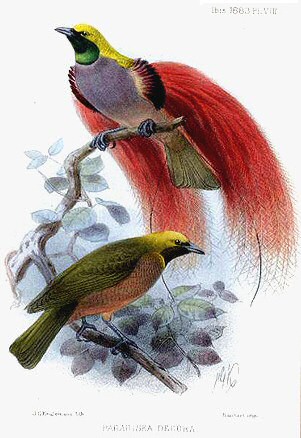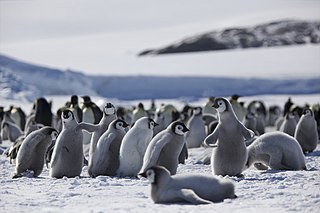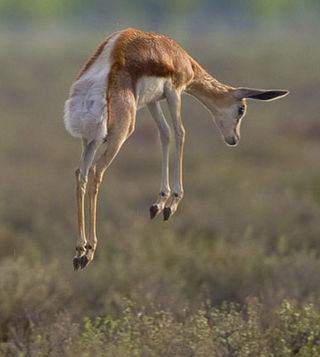
Sexual selection is a mechanism of evolution in which members of one biological sex choose mates of the other sex to mate with, and compete with members of the same sex for access to members of the opposite sex. These two forms of selection mean that some individuals have greater reproductive success than others within a population, for example because they are more attractive or prefer more attractive partners to produce offspring. Successful males benefit from frequent mating and monopolizing access to one or more fertile females. Females can maximise the return on the energy they invest in reproduction by selecting and mating with the best males.

Aggression is a behavior aimed at opposing or attacking something or someone. Though often done with the intent to cause harm, it can be channeled into creative and practical outlets for some. It may occur either reactively or without provocation. In humans, aggression can be caused by various triggers. For example, built-up frustration due to blocked goals or perceived disrespect. Human aggression can be classified into direct and indirect aggression; while the former is characterized by physical or verbal behavior intended to cause harm to someone, the latter is characterized by behavior intended to harm the social relations of an individual or group.

The digit ratio is the ratio taken of the lengths of different digits or fingers on a hand.

A lek is an aggregation of male animals gathered to engage in competitive displays and courtship rituals, known as lekking, to entice visiting females which are surveying prospective partners with which to mate. It can also refer to a space used by displaying males to defend their own share of territory for the breeding season. A lekking species is characterised by male displays, strong female mate choice, and the conferring of indirect benefits to males and reduced costs to females. Although most prevalent among birds such as black grouse, lekking is also found in a wide range of vertebrates including some bony fish, amphibians, reptiles, mammals, and arthropods including crustaceans and insects.

Behavioral ecology, also spelled behavioural ecology, is the study of the evolutionary basis for animal behavior due to ecological pressures. Behavioral ecology emerged from ethology after Niko Tinbergen outlined four questions to address when studying animal behaviors: What are the proximate causes, ontogeny, survival value, and phylogeny of a behavior?

The handicap principle is a disputed hypothesis proposed by the Israeli biologist Amotz Zahavi in 1975. It is meant to explain how "signal selection" during mate choice may lead to "honest" or reliable signalling between male and female animals which have an obvious motivation to bluff or deceive each other. The handicap principle suggests that secondary sexual characteristics are costly signals which must be reliable, as they cost the signaller resources that individuals with less of a particular trait could not afford. The handicap principle further proposes that animals of greater biological fitness signal this through handicapping behaviour, or morphology that effectively lowers overall fitness. The central idea is that sexually selected traits function like conspicuous consumption, signalling the ability to afford to squander a resource. Receivers then know that the signal indicates quality, because inferior-quality signallers are unable to produce such wastefully extravagant signals.
The game of chicken, also known as the hawk-dove game or snowdrift game, is a model of conflict for two players in game theory. The principle of the game is that while the ideal outcome is for one player to yield, individuals try to avoid it out of pride, not wanting to look like "chickens." Each player taunts the other to increase the risk of shame in yielding. However, when one player yields, the conflict is avoided, and the game essentially ends.
Evolutionary game theory (EGT) is the application of game theory to evolving populations in biology. It defines a framework of contests, strategies, and analytics into which Darwinian competition can be modelled. It originated in 1973 with John Maynard Smith and George R. Price's formalisation of contests, analysed as strategies, and the mathematical criteria that can be used to predict the results of competing strategies.

Dog aggression expressed by dogs is considered to be normal behaviour and various types of aggression are influenced by a dog's environment and genetic predisposition. Dogs commonly display possessive aggression when defending resources or themselves.

Within evolutionary biology, signalling theory is a body of theoretical work examining communication between individuals, both within species and across species. The central question is when organisms with conflicting interests, such as in sexual selection, should be expected to provide honest signals rather than cheating. Mathematical models describe how signalling can contribute to an evolutionarily stable strategy.

In animal communication, an alarm signal is an antipredator adaptation in the form of signals emitted by social animals in response to danger. Many primates and birds have elaborate alarm calls for warning conspecifics of approaching predators. For example, the alarm call of the blackbird is a familiar sound in many gardens. Other animals, like fish and insects, may use non-auditory signals, such as chemical messages. Visual signs such as the white tail flashes of many deer have been suggested as alarm signals; they are less likely to be received by conspecifics, so have tended to be treated as a signal to the predator instead.
In biology, resource holding potential (RHP) is the ability of an animal to win an all-out fight if one were to take place. The term was coined by Geoff Parker to disambiguate physical fighting ability from the motivation to persevere in a fight. Originally the term used was 'resource holding power', but 'resource holding potential' has come to be preferred. The latter emphasis on 'potential' serves as a reminder that the individual with greater RHP does not always prevail.

Intraspecific competition is an interaction in population ecology, whereby members of the same species compete for limited resources. This leads to a reduction in fitness for both individuals, but the more fit individual survives and is able to reproduce. By contrast, interspecific competition occurs when members of different species compete for a shared resource. Members of the same species have rather similar requirements for resources, whereas different species have a smaller contested resource overlap, resulting in intraspecific competition generally being a stronger force than interspecific competition.
In evolution, cooperation is the process where groups of organisms work or act together for common or mutual benefits. It is commonly defined as any adaptation that has evolved, at least in part, to increase the reproductive success of the actor's social partners. For example, territorial choruses by male lions discourage intruders and are likely to benefit all contributors.

Agonistic behaviour is any social behaviour related to fighting. The term has broader meaning than aggressive behaviour because it includes threats, displays, retreats, placation, and conciliation. The term "agonistic behaviour" was first defined and used by J.P Scott and Emil Fredericson in 1951 in their paper "The Causes of Fighting in Mice and Rats" in Physiological Zoology.Agonistic behaviour is seen in many animal species because resources including food, shelter, and mates are often limited.

A courtship display is a set of display behaviors in which an animal, usually a male, attempts to attract a mate; the mate exercises choice, so sexual selection acts on the display. These behaviors often include ritualized movement ("dances"), vocalizations, mechanical sound production, or displays of beauty, strength, or agonistic ability.

The goldeneye cichlid is a species of cichlid found in fresh water from the Aruka River in Guyana, to the Maroni River in Suriname. It is often found on flooded savannas near the coast. The male grows to a length of about 5.6 centimetres (2.2 in) while the female is somewhat smaller, and is thus regarded as a dwarf cichlid.
Aggression refers to agonistic behaviors characterized by threats and physical force. Methods of aggression in fish vary widely by species, but some common examples are chasing, charging, biting, fin display, color changes, and flared gills. Aggression is an important evolutionary pressure that increases an individual's access to resources while reducing overall conflict within the social group. Fish use aggressive behaviors to defend a territory, establish dominance, appeal to potential mates, and protect their young.
Female intrasexual competition is competition between women over a potential mate. Such competition might include self-promotion, derogation of other women, and direct and indirect aggression toward other women. Factors that influence female intrasexual competition include the genetic quality of available mates, hormone levels, and interpersonal dynamics.
Social rank theory provides an evolutionary paradigm that locates affiliative and ranking structures at the core of many psychological disorders. In this context, displays of submission signal to dominant individuals that subordinate group members are not a threat to their rank within the social hierarchy. This helps to achieve social cohesion. According to social rank theory, anxiety and depression are natural experiences that are common to all mammalian species. It is the pathological exaggeration of anxiety and depression that contributes to psychological disorders.













